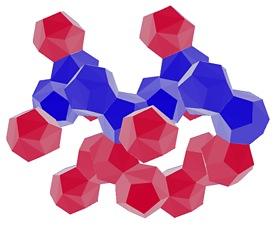

12/27/2010

Superconductors are of significant technological as well as scientific interest. Their ability to transport electrical current without resistance could provide significant energy savings, yet the known superconductors only display their superconducting properties at temperatures close to absolute zero. Although the recent discovery of a ‘high-temperature’ class of superconductors — which despite their name only become superconducting below –100 °C — suggests that room-temperature superconductivity might one day be possible, scientists still do not understand their physics sufficiently well to raise the zero-resistance transition temperature of these compounds significantly.
Returning to the classical, low-temperature superconductors, researchers from the WPI-AIMR in collaboration with colleagues from Hiroshima University and Yamaguchi University in Japan have now unveiled the possibility of increasing the transition temperature by judicious design of the material’s crystal structure1.
There are fundamental differences between the mechanisms of superconductivity in classical and high-temperature superconductors. In the classical case, superconductivity arises from the interaction between electrons and vibrations of the crystal lattice, known as phonons. In the high-temperature case, superconductivity is thought to arise through interactions between the electrons themselves, mediated by their magnetic properties.
The classical superconductors studied by the researchers have a clathrate crystal structure (Fig. 1) formed by a network of silicon or germanium cages that encapsulate barium guest atoms. The barium guests are free to ‘rattle’ within the cage, producing a particular type of phonon that can interact strongly with electrons. “The rattling motions in these cage materials are currently drawing attention as a possible way to increase superconducting temperatures,” says Katsumi Tanigaki from the research team.
The researchers revealed the influence of the cages on superconductivity through a detailed comparison between the properties of two clathrates, Ba24Si100 and Ba24Ge100, both of which are superconductors below their transition temperature. Of the two compounds, Ba24Ge100 has the larger cage and thus the stronger rattling motion. It would therefore be expected that it also has the higher transition temperature — but this is not the case. Its cage structure, it turns out, is too weak and distorted, which degrades its superconducting properties.
In principle, the findings point to the possibility of enhanced properties. “Our work suggests that a higher superconducting temperature may be realized if sufficiently strong cage materials can be designed,” comments Tanigaki. While the transition temperatures of clathrate superconductors are low at present, tuning the design of their cage structure may lead not only to higher superconducting temperatures in clathrates, but also to new strategies to improve other classical superconductors.
Tang, J., Xu, J., Heguri, S., Fukuoka, H., Yamanaka, S., Akai, K. & Tanigaki, K. Electron–phonon interactions of Si100 and Ge100 superconductors with Ba atoms inside. Physical Review Letters 105, 176402 (2010). | article
This research highlight has been approved by the authors of the original article and all information and data contained within has been provided by said authors.